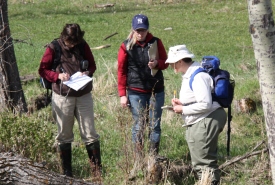Key research questions in Manitoba

Recording riparian plant species in Riding Mountain Natural Area, MB (Photo by NCC)
Informed and defensible land use and biodiversity conservation management decisions depend on the incorporation of the best available science, expert opinion and community values. The Nature Conservancy of Canada (NCC) conducts multi-scale planning designed to conserve the most important and viable natural areas, while still respecting local and provincial economies and local communities. One of the outcomes of this planning process is the identification of key knowledge gaps.
NCC's Manitoba Region is interested in participating in research partnerships designed to address these knowledge gaps. NCC wishes to forge/strengthen research projects in its priority natural areas and on its properties. Where projects align with NCC’s conservation goals, we will consider supporting researchers through in-kind data, expertise, lodging, access to lands and (if congruencies are high and resources allow) funds.
Researchers interested in partnering with NCC on projects listed below should contact the Manitoba Region’s Conservation Science Manager to discuss their proposed project.
Contact information is available here >
Key research questions in the Manitoba Region
(Note: this list is valid as of June, 2014 and will change as knowledge gaps are addressed and new information gaps arise).
- Association between grazing and vascular plant biodiversity in the sandhills of extreme southwestern Manitoba
- Biodiversity of non-active gravel extraction sites and trails, and implications for conservation land management
- Classification and management of alvar communities in the Interlake region
- Climate change adaptation of strategic biodiversity conservation actions
- Comparison of biodiversity benefits or establishing various perennial grassland types (tame, locally-sourced seed, non-locally sourced seed)
- Condition of lotic aquatic systems in the Whitemouth River Watershed
- Condition of permanent and semi-permanent wetlands in extreme southwestern Manitoba
- Examination of factors influencing long-term economic sustainability of local plant community restoration industry
- Extent and condition of fescue prairie and mixed-grass prairie in the Riding Mountain Aspen Parkland
- Extent and condition of tall grass prairie and other native grasslands in the south Interlake
- Extent, landscape patterns and condition of ephemeral and temporary wetlands in extreme southwestern Manitoba
- Fire ecology of native mixed-grass prairie in extreme southwestern Manitoba
- Hydrology of extensive wetland complexes in the Tall Grass Prairie ecoregion
- Integrating socio-economic-environmental knowledge in the Tall Grass Prairie
- Large mammal ecology in the Tall Grass Prairie
- Life history of Poweshiek skipperling
- Mapping remnant mixed-grass prairie in extreme southwest Manitoba
- Peatland community restoration techniques in the Whitemouth River Watershed
- Relationship between land use matrix, land management and pollinator diversity abundance
- Relationship between leafy spurge, species at risk distribution and abundance and control techniques
- Status of sandhill prairie and sand blowouts in extreme southwestern Manitoba
- Status of species at risk in key NCC work areas




